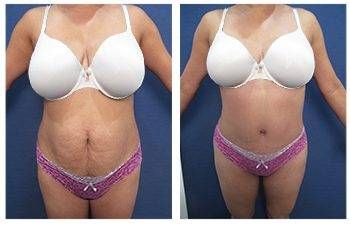




Introduction: abdominal scar following tummy tuck
Will I have an abdominal scar following tummy tuck surgery? Unfortunately, regardless of which board-certified surgeon you go to, the answer is a resounding, “Yes”. We emphatically answer this question not to scare you from having surgery but to assure you that any excisional surgeries will result in an excisional incision line. The goal of any excisional surgery is to ensure that your incision heals optimally and that your subsequent incision line is hidden and well camouflaged.
A tummy tuck is an incredible, life-changing cosmetic plastic surgery procedure that can not only improve your appearance but your confidence and quality of life as well. As such, it is important to ensure that the excisional surgery heals and is non-obtrusive visually.
How well a tummy tuck scar heals is one of the most important factors when judging whether a cosmetic surgery was successful. A poorly stitched and poorly healed scar can ruin even the most beautiful and lean abdomen and waistline.
What kind of abdominal scar you will inevitably be left with is determined by several factors that include intrinsic factors dependent on your healing capacity but also extrinsic factors. Certain extrinsic factors are under your control and others are not. For example, the choice of sutures and surgical technique used are critical factors. Moreover, how tight you make the closure is an important consideration. The more aggressive you are with redundant skin excision, the better the stomach contour will look, but the amount of skin excised is directly proportionate to the tightness in skin closure; the tightness of skin closure will translate to a more aggressive scar. A final influencer in ultimate scar healing is also your postoperative compliance with remaining in a semiflexed position and wearing your compression garments which both promote an optimally healed incision.
Additionally, much of the scar appearance depends on postoperative scar management. Postoperative scar management may require the application of topical silicone tape and gel as well as possible IPL therapy, and even consideration of steroid injections. That is why every patient at SurgiSculpt is given extensive high-definition body contouring post-operative instructions prior to their initial consultation.
They are also seen regularly at our office in the days and weeks following surgery to ensure the incision line is healing properly. A typical abdominal scar following a tummy tuck will heal throughout the first 6 months after your surgery.
The Essence of Abdominoplasty
Abdominoplasty, commonly known as a tummy tuck, is more than just a cosmetic procedure. It’s a journey towards achieving a desired body contour, often after significant weight loss or post-pregnancy. The primary goal is to remove excess fat and skin from the abdominal region. When combined with liposuction and muscle tightening, the results can be transformative, leading to a more contoured, smoother, and slimmer abdomen. This not only enhances the overall appearance but also boosts self-confidence and mental well-being.
The Inevitability of Scars
The scars resulting from a tummy tuck are carefully planned. Their positioning largely depends on the type of abdominoplasty performed. A horizontal scar across the lower abdomen is standard, strategically placed to be easily concealed by most underwear and swimwear. A scar around the belly button is common for full abdominoplasty procedures, designed to blend with the natural contours of the navel. In some cases, vertical scars might also be present. Their length and positioning depend on the patient’s skin condition and the surgery’s specifics.
Positioning and Types of Scars
While most scars heal normally, some patients might experience abnormal scarring. This includes hypertrophic scars, which are raised and red but don’t grow over time, and keloid scars, which extend beyond the original wound site. It’s essential to be aware of these possibilities and consult with a plastic surgeon if any abnormality is noticed.
Abnormal Scarring: What to Know
While most scars heal normally, some patients might experience abnormal scarring. This includes hypertrophic scars, which are raised and red but don’t grow over time, and keloid scars, which extend beyond the original wound site. It’s essential to be aware of these possibilities and consult with a plastic surgeon if any abnormality is noticed.
The Healing Journey of Tummy Tuck Scars
The body’s ability to heal is nothing short of miraculous. The journey of scar healing post-abdominoplasty is a testament to this incredible capability.
Immediate Post-Surgery Phase
In the days following the surgery, the incision site undergoes several changes. It typically appears red and thin. Swelling, inflammation, and a slight oozing are common. The body’s cells work diligently to close the wound, producing a collagen network. This collagen acts as a bridge, holding the wound edges together.
Transition from Weeks to Months
The dynamic nature of wound healing becomes evident as weeks turn into months. The initially disorganized collagen undergoes a transformation. It gets replaced with a more structured form, leading to a stronger wound site. The scar might still appear dark initially, but with time, it starts to flatten and fade. This phase is crucial, and proper care can significantly influence the scar’s final appearance.
The Maturation Phase: Six Months and Beyond
Around the six-month mark, the scars begin their final transformation. They start to lose their pigmentation, changing from a prominent red to a more subtle rosy pink or soft brown. By the time a year has passed, the scars have matured. The swelling is completely gone, and the scars have faded considerably, blending with the surrounding skin.
Tips to Enhance Scar Healing
Scar management post abdominoplasty is crucial. With the right care, the appearance of scars can be significantly minimized.
- Follow Postoperative Instructions: Adhering to the guidelines provided by the plastic surgeon is paramount. These instructions are tailored to promote optimal healing and minimize complications.
- Dietary Considerations: Nutrition plays a pivotal role in wound healing. A diet rich in protein, vitamins, and minerals can expedite the healing process. Foods rich in vitamin C and zinc, in particular, are beneficial.
- Avoid Sun Exposure: UV rays can darken the scars, making them more noticeable. It’s essential to keep them covered, especially during peak sun hours. Using a broad-spectrum sunscreen can also help.
- Lifestyle Changes: Habits like smoking can impair wound healing and lead to more prominent scars. Adopting a healthy lifestyle, including quitting smoking and maintaining a stable weight, can have a positive impact on scar healing.
- Scar Treatments: There are several treatments available that can enhance scar appearance. These include silicone gel sheets, scar massage, and laser treatments. It’s essential to consult with a dermatologist or plastic surgeon before starting any treatment.
In Conclusion: abdominal scar with tummy tuck
Abdominoplasty is a transformative procedure with lasting results. While scars post a tummy tuck are unavoidable, with proper care and management, they can be made less noticeable. The benefits of a tummy tuck, such as a slimmer profile, enhanced self-confidence, and improved mental well-being, often outweigh concerns about scarring. Always consult with a board-certified plastic surgeon to ensure the best results and optimal scar management.
This 63-year-old female 3 months following an abdominoplasty procedure to achieve the desired results.
